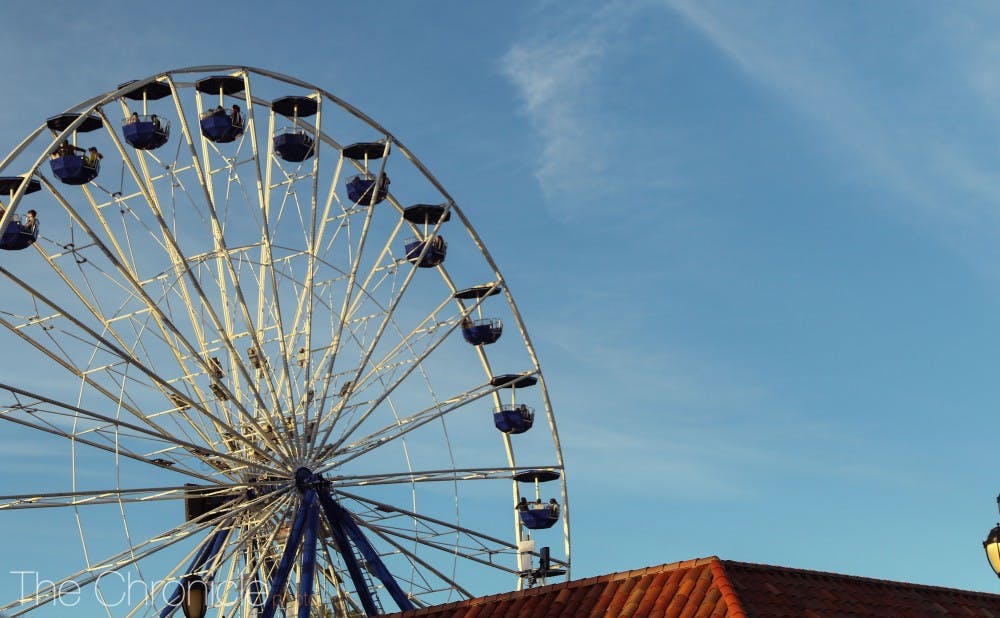Lee Baker, Mrs. Alexander Hehmeyer professor of cultural anthropology, has done research on the traditions of fairs. Since the North Carolina State Fair is in town this week, The Chronicle spoke with Baker about his interest in the events and the sociological concepts behind them. The interview has been edited for length and clarity.
The Chronicle: What sparked your interest in state fairs and similar rituals and celebrations?
Lee Baker: I’ve done research on world fairs in the United States and other countries during the turn of the century. As I’ve done this, I’ve found that there are many parallels between the historical genealogies of state fairs and those of these world fairs and other expositions—so that’s sort of how I became interested in the subject. I’m also a more general anthropologist of North America, so there are some principals and analysis that I can bring to bear to help explain these annual rituals in the United States and the parallels between them and those in other countries and cultures.
TC: What are some of these parallels between state fairs in the United States and other celebrations/expositions around the world?
LB: There are many. A lot of Americans think, “Oh we don’t really have culture,” but that’s not true. When you make that bonfire and burn the benches after the Carolina games, that’s a feature of an expressive culture that’s just as exotic as some sacrifice in the hills of Papua New Guinea. The state fair is another aspect of this culture.
Whether it’s in Minnesota, North Carolina, or Colorado, the fair not only marks the transitions between the seasons, but also celebrates family and community. These fairs are structured similarly to other big carnivals, like Carnival in Brazil or Mardi Gras. When people come together in big groups to celebrate something like this, unique things can happen. Rules are relaxed—you get to break them for a moment as part of a celebration of a larger community.
You can light something on fire in the middle of the quadrangle for a brief period of time to celebrate this sense of unity. So that’s where the fair comes in as well. You spend too much money. You eat stuff you would never eat on a normal day. People push the limits—deep fried anything. That’s all part of the fun and part of the celebration of community and family.
TC: How is the state fair historically similar to world fairs throughout the past century?
LB: World fairs have always been employed as opportunities to celebrate technology, new innovations and the like. This element of exposition is consistent between the world fairs of the last 100 years and modern state fairs. For state fairs, the focus is agriculture. Even though nowadays only a small percent of the population produces all the food and goods in the United States, the fair still stays true to its farming and husbandry traditions and maintains this exposition feel. It’s one of the few times farming and agriculture are raised to a level of respect and adoration.
TC: Do you foresee the fair evolving at all as parts of the United States become increasingly urbanized and a decreasing percentage of the population becomes involved in agriculture?
LB: I don’t think so. I think these fairs have established very durable traditions, so I don’t think the format, the structure, the celebration or the food is going to change too much. State fairs have been remarkably resilient in that they haven’t evolved much since the 1940s or 1950s. I think that one reason for this is that people want their kids to have experiences similar to the experiences that they had as kids.
There’s a generational link—the grandma’s fair is very similar to the mother’s fair, which is very similar to the daughter’s fair. I think state fairs in general appeal to nostalgia and hearken back to the “good old days.” It’s a moment to reflect upon the past or do something familiar that is not necessarily progressive. I don’t think there’s a widespread desire for the fair to evolve with the times. We could easily be playing virtual reality or high-tech shooter games, and instead we’re throwing softballs at milk cans and darts at balloons.
TC: What is your favorite aspect of the state fair? Does your family have any particular traditions associated with the event?
LB: My family has been going since my kids were young. I love gardening, and my hobby is collecting and growing house plants—drives my wife crazy—so I like to go to the exhibits on the plants. My wife is a quilter, so she gets excited about the quilting exhibits. We usually stop by the farm animals and the fun house for the kids. My son loves the fun house. Then we get food—our turkey legs, our corn and usually a funnel cake—and go on four or five rides. We try to only go on a few You can’t do 20 of them, you would go broke!
TC: Are there any aspects of the North Carolina State Fair specifically that you find particularly intriguing?
LB: Well it’s an integral part of American culture, that’s for sure. It’s a celebration of North Carolina and, by default, our diversity. When you walk through the state fair, the level of diversity is incredible. You see the South Asians from Cary, the Mexican families from Durham, the Republicans, the Democrats. You see rich people, poor people, working class, middle class. The full range of humanity is at the fair.
To me, that is a true celebration of North Carolina and North Carolina’s diversity. Everyone feels welcome—spending too much money and eating things that they shouldn’t be.
Get The Chronicle straight to your inbox
Signup for our weekly newsletter. Cancel at any time.

